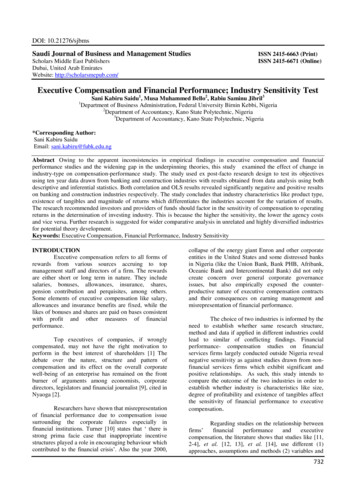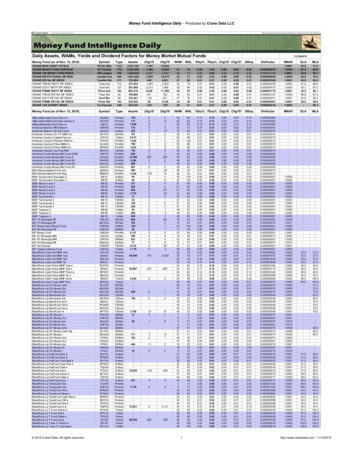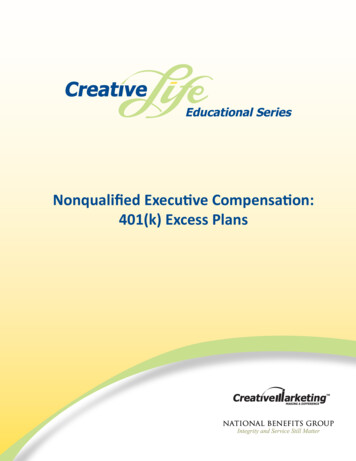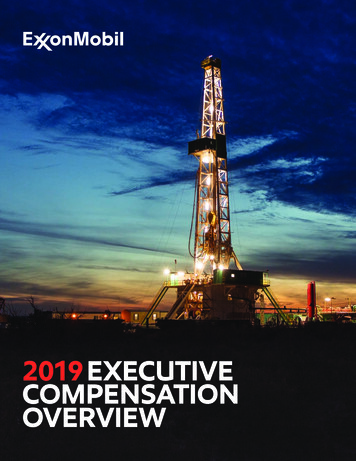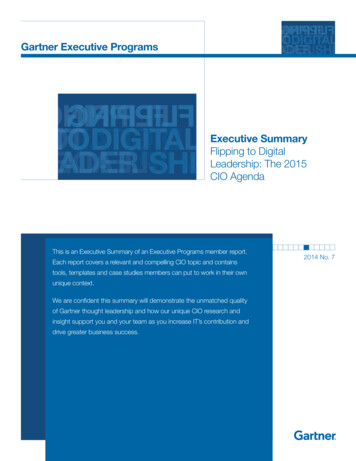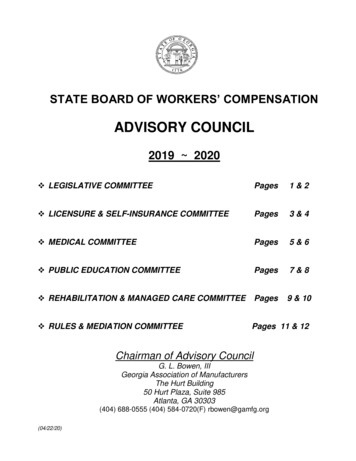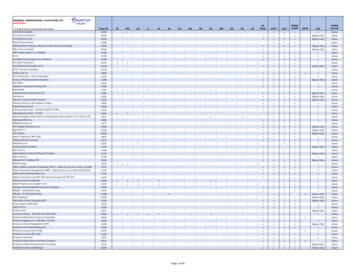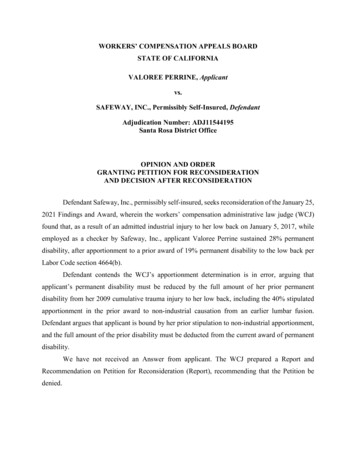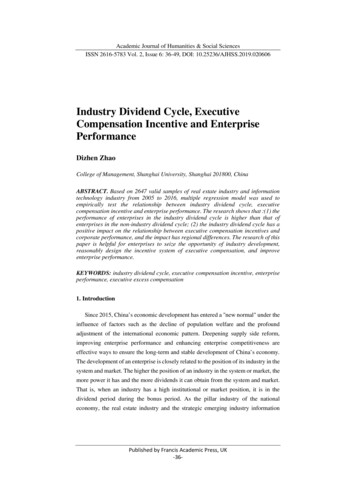
Transcription
Academic Journal of Humanities & Social SciencesISSN 2616-5783 Vol. 2, Issue 6: 36-49, DOI: 10.25236/AJHSS.2019.020606Industry Dividend Cycle, ExecutiveCompensation Incentive and EnterprisePerformanceDizhen ZhaoCollege of Management, Shanghai University, Shanghai 201800, ChinaABSTRACT. Based on 2647 valid samples of real estate industry and informationtechnology industry from 2005 to 2016, multiple regression model was used toempirically test the relationship between industry dividend cycle, executivecompensation incentive and enterprise performance. The research shows that :(1) theperformance of enterprises in the industry dividend cycle is higher than that ofenterprises in the non-industry dividend cycle; (2) the industry dividend cycle has apositive impact on the relationship between executive compensation incentives andcorporate performance, and the impact has regional differences. The research of thispaper is helpful for enterprises to seize the opportunity of industry development,reasonably design the incentive system of executive compensation, and improveenterprise performance.KEYWORDS: industry dividend cycle, executive compensation incentive, enterpriseperformance, executive excess compensation1. IntroductionSince 2015, China’s economic development has entered a "new normal" under theinfluence of factors such as the decline of population welfare and the profoundadjustment of the international economic pattern. Deepening supply side reform,improving enterprise performance and enhancing enterprise competitiveness areeffective ways to ensure the long-term and stable development of China’s economy.The development of an enterprise is closely related to the position of its industry in thesystem and market. The higher the position of an industry in the system or market, themore power it has and the more dividends it can obtain from the system and market.That is, when an industry has a high institutional or market position, it is in thedividend period during the bonus period. As the pillar industry of the nationaleconomy, the real estate industry and the strategic emerging industry informationPublished by Francis Academic Press, UK-36-
Academic Journal of Humanities & Social SciencesISSN 2616-5783 Vol. 2, Issue 6: 36-49, DOI: 10.25236/AJHSS.2019.020606technology industry have experienced the industry dividend cycle, which is the keyindustry to be studied.Since 1998, the real estate industry has experienced many stages of development.In 2008, the financial crisis led to a comprehensive recession of the economicenvironment and a significant slowdown in the development of the real estate industry.At the executive meeting of the state Council held on February 20, 2013, the "fivenational regulations" on the regulation of the real estate industry was issued, endingthe golden age of the real estate industry; after 2016, the real estate industry went toInventory has been listed as a national key issue, the real estate industry is facingmany difficulties. However, the information technology industry has entered a periodof rapid development since it was listed in the first batch of national standardformulation and revision project plans in 2006.In 2016, the development plan ofsoftware and information technology service industry (2016-2020) further promotedthe information technology industry to change from a big one Strong.Under the theoretical framework of management rights, executive compensationis the embodiment of management rights. The increasing control of management overthe company has brought about an impact that executives can more easily break theexisting system of power supervision and power checks and balances. As a result,executive compensation has become the performance of management rent-seeking,not an effective incentive way. The optimal contract theory holds that, the board ofdirectors can effectively supervise the management to make the optimalcompensation contract design, so as to maximize the interests of executives andshareholders at the same time. Although the theory of management power is totallydifferent from the theory of optimal contract, executive compensation incentive isalways a means to motivate executives to improve corporate performance. How toeffectively use the above theory to improve corporate performance is a commonproblem faced by enterprises. Industry dividend cycle reflects the support of the statein the system, market and other aspects of the industry. Can we design an appropriateexecutive compensation incentive system to improve enterprise performance incombination with industry dividend cycle? This is the problem to be solved in thispaper.Scholars at home and abroad have made a lot of achievements in the research onthe impact of corporate performance, but no scholars have explored the transfer effectPublished by Francis Academic Press, UK-37-
Academic Journal of Humanities & Social SciencesISSN 2616-5783 Vol. 2, Issue 6: 36-49, DOI: 10.25236/AJHSS.2019.020606of industry dividend on corporate performance from the perspective of industry. Inaddition, the existing research on executive compensation and corporate performancehas not reached the same conclusion, and few scholars combined with industrydividend cycle to study the relationship between executive compensation andcorporate performance. Based on this, this paper has two main innovations: (1) thefirst study of the industry dividend cycle on corporate performance, to explore theimpact of industry meso factors on corporate micro performance; (2) the industrydividend cycle will be included in the study of executive compensation and corporateperformance, and further explore the relationship between industry dividend cycle,executive excess compensation and corporate performance.2. Theoretical analysis and research hypothesis2.1 Industry dividend cycle and enterprise performanceUnder the influence of macro factors, the industry is in the leading position in thesystem and market. To obtain the system and market dividend is in the industrydividend cycle. The development of national strategy, system incentive, science andtechnology development and market demand are the key factors to determine whetherthe industry is in the dividend cycle.In terms of national strategic development, the real estate industry was positionedas a national pillar industry in 2003, and has been developing at a high speed sincethen. The government has promulgated a series of laws and regulations to regulate thereal estate market, strengthen management and supervision, which to a certain extentimproves the performance of real estate enterprises. Since the release of the 13th fiveyear plan for the development of national strategic emerging industries in 2016, thereal estate industry has been developing rapidly. Seven strategic emerging industriesrepresented by information technology industry have become the main driving forceof economic growth. In terms of institutional incentive, institutional environment isnot only positively related to the performance of start-up enterprises, but also canregulate the relationship between organizational redundancy and enterpriseperformance in economic transformation, which is conducive to improving enterpriseperformance. In the aspect of science and technology development, the developmentof science and technology must be the result of science and technology innovation.Published by Francis Academic Press, UK-38-
Academic Journal of Humanities & Social SciencesISSN 2616-5783 Vol. 2, Issue 6: 36-49, DOI: 10.25236/AJHSS.2019.020606Science and technology innovation can improve the utilization efficiency of resources,comprehensively enhance the core competitiveness of enterprises, and then improvethe performance of enterprises. In terms of market demand, market demand can notonly improve product quality, but also promote the transformation of emergingindustries, help enterprises innovate and improve enterprise performance.To sum up, the development of national strategy, system incentive, science andtechnology development and market demand will have a positive impact on enterpriseperformance. In the industry dividend cycle, the adjustment of national strategycreates many convenient conditions for the development of the industry. Variouspolicies issued by the government provide many new development opportunities forall walks of life. With the transformation of market economy, the progress of scienceand technology, and the industry structure. Many changes have begun to appear, therole of market demand is more obvious, the competitiveness of enterprises in someindustries has gradually increased, and the operation of enterprises will also directlyaffect the performance of enterprises. Therefore, the following assumptions areproposed:Hypothesis 1: industry dividend cycle is positively correlated with firmperformance. That is, the performance of enterprises in the industry dividend cycle isbetter than that in the non industry dividend cycle.2.2 Industry dividend cycle, executive compensation incentive and enterpriseperformanceSome scholars have done a lot of research on the relationship between executivecompensation and corporate performance. There is a positive correlation betweenexecutive compensation and company performance, but there are always significantdifferences between China and the United States. The compensation performancecontract relationship between listed companies and executives in China has beenbasically formed, and there is a significant positive correlation between executivecompensation and corporate performance. In the context of salary restriction, thepositive correlation between executive compensation and corporate performance issignificantly reduced. However, there is no correlation between the executivecompensation level, compensation structure and corporate performance.Published by Francis Academic Press, UK-39-
Academic Journal of Humanities & Social SciencesISSN 2616-5783 Vol. 2, Issue 6: 36-49, DOI: 10.25236/AJHSS.2019.020606From the research results of scholars at home and abroad, we can see that there isno unified conclusion between executive compensation and corporate performance. Itis necessary to introduce other regulatory variables to further study the correlationbetween executive compensation and corporate performance. In the enterprises withhigh financing constraints, there is a significant positive correlation betweenexecutive compensation and corporate performance. It can be seen that the industrydividend cycle does have an impact on the relationship between executivecompensation incentive and corporate performance. As a comprehensive reflection ofnational strategy, institutional incentive, technological development and marketdemand, does the industry dividend cycle have an impact on the relationship betweenexecutive compensation incentive and corporate performance? The change ofindustry cycle will have an impact on the financial strategic mode of enterprises. Thesystem environment has a significant impact on the incentive effect of executivecompensation. The better the business environment is, the higher the executivecompensation is, the higher the quality of enterprise accounting information is, andthe high-quality accounting information really improves the performance of thecompany, that is, the profit growth rate of the enterprise is synchronous with theindustry cycle.In conclusion, the industry dividend cycle will have an impact on the relationshipbetween executive compensation incentive and corporate performance. In addition,the eastern market-oriented process index is higher, the institutional environmentcauses institutional differences of listed companies, and regional factors become animportant factor affecting the performance of listed companies. Therefore, thefollowing assumptions are proposed:Hypothesis 2: the correlation between executives; excess compensation and theperformance of enterprises in the industry dividend cycle is higher than that ofenterprises in the non industry dividend cycle.Hypothesis 3: there are regional differences in the impact of industry dividendcycle on the correlation between executive compensation and corporate performance.Published by Francis Academic Press, UK-40-
Academic Journal of Humanities & Social SciencesISSN 2616-5783 Vol. 2, Issue 6: 36-49, DOI: 10.25236/AJHSS.2019.0206063. Research and Design3.1 Sample selection and data sourceThis paper takes 2005-2016 as the research area and China real estate listedcompanies and information technology listed companies as samples to explore therelationship between industry dividend cycle, executive compensation incentive andcorporate performance. In order to ensure the reliability and validity of the study, theinitial samples were processed and screened as follows: (1) ST and * ST enterpriseswere eliminated; (2) Enterprises with missing financial data were eliminated. Finally,2647 valid samples are obtained, and the sample data comes from CSMAR database.3.2 Definition of variables1. Explained variableEnterprise performance refers to the enterprise operating efficiency and operatorperformance in a certain period of operation. The level of enterprise operatingefficiency is mainly reflected in profitability, asset operation level, debt paying abilityand follow-up development ability. The performance of the operator is mainlyreflected by the achievements and contributions made by the operator to the operation,growth and development of the enterprise in the process of operation and management.In this paper, the return on total assets (ROA) is used to express enterpriseperformance.2. Explanatory variableIndustry dividend cycle is subject to national development strategy, systemincentives, scientific and technological development and market demand four factors.The influence of these four factors on the industry is concentrated in the performanceof the industry. Economic Value Added (EVA) is the most accurate measure tomeasure the performance of a company. It can make the most accurate andappropriate evaluation on the performance of a company in whatever period of time.The EVA ratio of industry net assets reflects the EVA created per unit net assets of theindustry. It can compare the growth of EVA in different industries with the same scalePublished by Francis Academic Press, UK-41-
Academic Journal of Humanities & Social SciencesISSN 2616-5783 Vol. 2, Issue 6: 36-49, DOI: 10.25236/AJHSS.2019.020606and analyze whether the industry is in the dividend cycle. The calculation formula ofEVA rate of industry net assets is:EVA rate of industry net assets Among them, the calculation formula of industry EVA is: industry EVA after-tax net operating profit of the industry - cost of capital of the industryWhen EVA ratio of industry net assets is positive, it means that the industry is inthe dividend cycle; when EVA ratio of industry net assets is negative, it means that theindustry is not in the dividend cycle. In this paper, dummy variable T represents theindustry dividend cycle, T 0 represents the dividend cycle, and T 1 represents thenon-dividend cycle.Executive compensation generally includes monetary compensation and stockoptions, etc., but for most listed companies in China, monetary compensation is stillthe most important way, and stock options and other incentive methods are notcommon. Overseas research on executive compensation mainly focuses on CEOcompensation, while domestic research on the impact of company informationdisclosure tends to examine the compensation level of the top three executives。Therefore, this paper uses the natural logarithm (lnap) of the top three executives toexpress executive compensation incentive.3. Control variableThis paper selects size, tobinq, oc10 and area as control variables. The variablesinvolved in this paper and their measurement are shown in Table 1:Published by Francis Academic Press, UK-42-
Academic Journal of Humanities & Social SciencesISSN 2616-5783 Vol. 2, Issue 6: 36-49, DOI: 10.25236/AJHSS.2019.020606Table 1 Variable definitionVariable typeVariable nameVariablesymbolVariable definitionExplainedvariableEnterprise performanceROAReturn on total assetsIndustry dividend cycleTT 0 for dividend period, t 1 for non dividend periodExecutive compensationNatural logarithm of top three nvariableThe difference between the actual salary and theExecutive overpayment OVERAPexpected salary of senior executivesEnterprise scaleSIZE Natural logarithm of total assets at the end of the periodEnterprise growthTOBINQTobin Q valueEquity concentrationOC10Shareholding ratio of top ten shareholderscontrol variableIntangible assets ratioIAIntangible assets / total assets of the enterpriseIf east 1, the enterprise is located in the East, and theBusiness areaEASTrest is 03.3 Model constructionIn order to test the hypothesis proposed in this paper, the following regressionmodels are constructed:Build model 1 based on assumption 1:(1)Build model 2 based on assumption 2:(2)Build model 3 according to hypothesis 3:(3)Among them, ROA represents enterprise performance, T represents the virtualvariable of industry dividend cycle, lnap represents executive compensation incentive,size represents enterprise scale, tobinq represents enterprise growth, oc10 representsthe shareholding ratio of the top ten shareholders of the enterprise, and East representsthe region of the enterprise.Published by Francis Academic Press, UK-43-
Academic Journal of Humanities & Social SciencesISSN 2616-5783 Vol. 2, Issue 6: 36-49, DOI: 10.25236/AJHSS.2019.0206064. Empirical Analysis4.1 Descriptive statisticsTable 2 is the descriptive statistical results of main variables. In order to excludethe influence of extreme values, the variable observed values were winsorizeprocessed with 1% quantile in this paper. It can be seen from table 2 that the ROA is0.031, the maximum value is 0.496, and the minimum value is -3.856, indicating thatthe performance of listed enterprises in information technology industry and realestate industry is at a low level, which is mainly related to China economicdevelopment entering the "new normal"; the standard deviation of T is close to 0.5,indicating that there is a change in industry dividend cycle and the development ofenterprises is far away. The maximum value of lnap is more than 17, and theminimum value is less than 11, which shows that enterprises pay different attention tothe compensation of executives. In terms of control variables, the standard deviationof control variables such as size and tobinq is large, which shows that there is a greatheterogeneity in enterprise size and growth. Descriptive statistical results indirectlyshow that it is feasible to study the relationship between industry dividend cycle,executive compensation incentive and corporate performance.Table 2 Descriptive 2.393OC10264711.19097.490EAST264701Source: calculated based on CSMAR database v.0.1450.4500.8821.4613.36016.0890.3754.2 Correlation analysisTable 3 shows the person correlation coefficient between enterprise performanceand test variables. It can be seen, at the significance level of 5%, there is a significantPublished by Francis Academic Press, UK-44-
Academic Journal of Humanities & Social SciencesISSN 2616-5783 Vol. 2, Issue 6: 36-49, DOI: 10.25236/AJHSS.2019.020606positive correlation between industry dividend cycle and executive compensationincentive and enterprise performance, which lays the foundation for the researchhypothesis of this paper. In terms of control variables, there is a significant correlationbetween enterprise SIZE, TOBING and ROE. In addition, the correlation coefficientof any two variables is less than 0.6, so it can be preliminarily considered that there isno serio
Compensation Incentive and Enterprise Performance . Dizhen Zhao . College of Management, Shanghai University, Shanghai 201800, China. ABSTRACT. Based on 2647 valid samples of real estate industry and information technology industry
